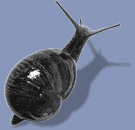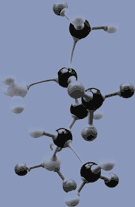Story by Connie McDougall


Biology major Jill Cook admits to being nervous when she attended the Eighth Regional Conference of Undergraduate Research in late October.
 She attended the gathering with a poster that explained her research
project on the immune system of mollusks to other top students and
professors from around the Northwest. "I felt confident in the lab, but I
wondered if I'd be able to answer all the questions at the conference."
She attended the gathering with a poster that explained her research
project on the immune system of mollusks to other top students and
professors from around the Northwest. "I felt confident in the lab, but I
wondered if I'd be able to answer all the questions at the conference."
Not only did she answer them, she was delighted to find people were interested in her work. "It was a wonderful experience," she says.
Eight other Seattle Pacific University science students, five of whom presented posters, joined Cook at the gathering sponsored by the Murdock College Science Research Program and held at Oregon's Linfield College. Seven SPU faculty members also attended.
Increasingly, Seattle Pacific undergraduate students in disciplines as varied as biology, chemistry, physics, psychology, family consumer sciences and communication are venturing into what was previously the province of graduate students: the research laboratory.
Amorah Lee, a senior biology major, has been working collaboratively with Assistant Professor of Biology Tim Nelson for two years. SPU's Blakely Island field Station is the ideal setting for their study of a phenomenon called "green tides" in which there are sudden, unexplained large blooms of green algae in Northwest waters.
 "Working on this project will really help me get into graduate school,"
says Lee. "Now I know what research takes, and I've found out that it's very
creative. I'm very lucky to have had this opportunity."
"Working on this project will really help me get into graduate school,"
says Lee. "Now I know what research takes, and I've found out that it's very
creative. I'm very lucky to have had this opportunity."
She is fortunate in more ways than one. Because Nelson received a grant to fund the research, Lee and another student, Kari Jones, are paid for their contributions.
Even unpaid, undergraduate research opportunities are hard to come by at most universities. The projects require extra work from the student, and they put additional loads on professors, who must bring each student along, teaching the basics so the student can do effective research. It's very labor- intensive, considering that the student then graduates and leaves.
Nevertheless, Associate Professor of Biology Rick Ridgway, who is currently assisting eight students with research projects, says the results are worth it. "Undergraduate research shows students what it means to be a scientist. They have to assemble equipment, possibly find funding, design the experiment and ask the right questions," he says.
"The students learn that if you ask one question, that one leads to 10 more," adds Assistant Professor of Biology Cindy Fitch.
"They're seeing real science in action, applying what they've read about," explains Nelson. "Students also see that there are no guarantees in science, no sure bet you'll end up with anything of value -- which is a different experience than taking a class. In class, you know you'll end up with a grade, no matter what. Research puts a different pressure on students. It's tougher, and their work is very critically reviewed. Everyone asks, 'Is this good science?'"
Jill Cook found the experience exhilarating. With Rick Ridgway, she worked with snails, tracking a protein in the blood systems of mollusks, the presence of which had never been documented before. "We made a new discovery, and that's exciting," she says.
While Ridgway says it's not the leading edge of scientific research, "there is still a lot of good work that can be done by undergraduates. They can fill in the gaps. It's valuable because they are adding to the knowledge base."
All students who earn a bachelor of science degree at Seattle Pacific must produce a research project of some kind, but not everyone is able to find the professor-supervised research that Jill Cook and Amorah Lee have enjoyed. For those students, internships or work-study positions are available at various laboratories in Seattle, including Immunex and the Fred Hutchinson Cancer Research Center.
The emphasis on undergraduate research is growing at Seattle Pacific even as it is becoming a priority nationally, especially for students who plan on graduate school. Assistant Professor of Chemistry Daisy Zhang is working with a student on quantum mechanics calculations. "I know these experiences are important because I did research as an undergraduate, a little bit of DNA sequencing during the summer," she says. "It taught me how to read the literature, what's been done before and what hasn't been done. That's critical."
Assistant Professor of Physics John Lindberg, who started at SPU this fall, already has students working on one of his projects. "Diabetics have to stick their fingers three or four times a day to take a glucose reading," he says. "Scientists are asking, 'Can we make measurements of blood glucose by shining light through the hand?' It's called spectroscopy, and there's a long way to go."
Right now, undergraduate research on campus is carried out in facilities which were not designed for it, but that's soon to change with construction of a new science building. "The new building will give us dedicated undergraduate research spaces," says Nelson. "We'll have 24-hour labs so students can come in day or night to work."
For Jill Cook, who has wanted to be a neurosurgeon since she was 10 years old, the chance to do real science has been priceless. "I know that when I apply to medical school I'll have something to talk about. They'll ask if I've ever done any kind of research and I'll be able to say, 'Yes, I did.' It's a great advantage."

All students who earn a bachelor of science degree at Seattle Pacific must produce a research project of some kind, but not everyone is able to find the professor-supervised research that Jill Cook and Amorah Lee have enjoyed. For those students, internships or work-study positions are available at various laboratories in Seattle, including Immunex and the Fred Hutchinson Cancer Research Center.
The emphasis on undergraduate research is growing at Seattle Pacific even as it is becoming a priority nationally, especially for students who plan on graduate school. Assistant Professor of Chemistry Daisy Zhang is working with a student on quantum mechanics calculations. "I know these experiences are important because I did research as an undergraduate, a little bit of DNA sequencing during the summer," she says. "It taught me how to read the literature, what's been done before and what hasn't been done. That's critical."
Assistant Professor of Physics John Lindberg, who started at SPU this fall, already has students working on one of his projects. "Diabetics have to stick their fingers three or four times a day to take a glucose reading," he says. "Scientists are asking, ‘Can we make measurements of blood glucose by shining light through the hand?' It's called spectroscopy, and there's a long way to go."
Right now, undergraduate research on campus is carried out in facilities which were not designed for it, but that's soon to change with construction of a new science building. "The new building will give us dedicated undergraduate research spaces," says Nelson. "We'll have 24-hour labs so students can come in day or night to work."
For Jill Cook, who has wanted to be a neurosurgeon since she was 10 years old, the chance to do real science has been priceless. "I know that when I apply to medical school I'll have something to talk about. They'll ask if I've ever done any kind of research and I'll be able to say, ‘Yes, I did.' It's a great advantage."
![]()

| Please read our
disclaimer.
Send any questions, comments or correspondence about Response to
jgilnett@spu.edu or call 206-281-2051. Copyright © 2000 University Communications, Seattle Pacific University.
Seattle Pacific University |